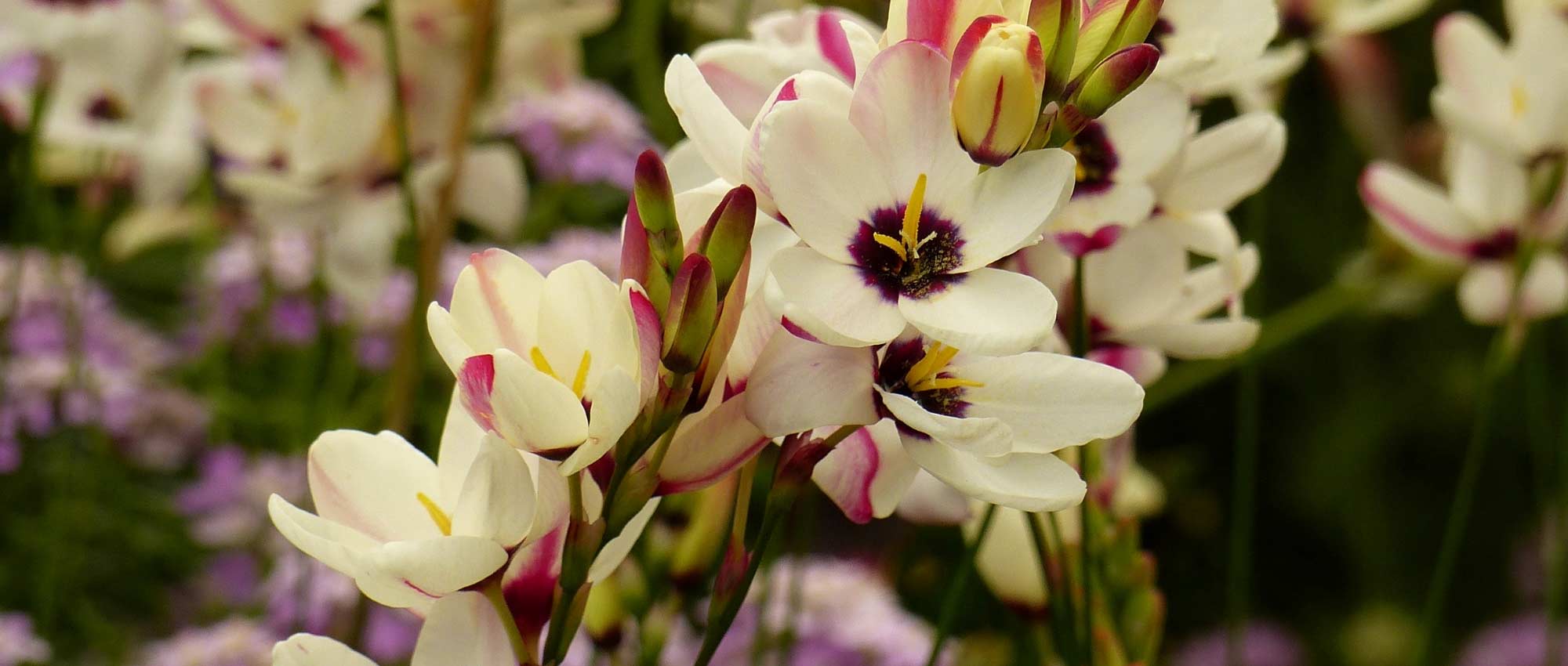
Ixia: planting, growing and care
Contents
Ixia in a nutshell
- Ixia produces superb star-shaped flowers in summer, gathered in spikes
- It declinates into a wide palette of bright, luminous colours
- Ixia has an upright, elegant silhouette and fine foliage of a clear bright green
- Ixia thrives in sun and well-draining soil and is not susceptible to diseases and parasitic organisms
A word from our Expert
Ixias are perennial plants that offer an elegant, generous flowering in summer. Their flowers are star-shaped, gathered in spikes, and come in a beautiful range of colours: pink, red, mauve, white, yellow, orange… They are very nicely contrasted by a darker maculate spot at the centre, giving great depth to the flowering. These flowers are ideal for creating bouquets. Foliage is fine and elongated, with a lovely green hue, very decorative.
Ixias are ideal for bringing plenty of colour to borders! The variety Ixia ‘Venus’ stands out for its vivid, bright pink flowering. White-flowered varieties, such as Ixia ‘Giant’, are prized for their elegance and can find a place in romantic borders or cottage gardens. But these superb perennials are also suitable for growing in pots or containers, and can therefore be placed on a patio close to the house to add plenty of colour and brightness!
Ixias will thrive in a warm, sunny position, on soil that is both well-draining and fertile. They are rarely affected by diseases or parasitic organisms, and multiply quite easily by dividing the corms. Their only drawback is being somewhat tender: it is best to lift the corms and overwinter them in frost-free conditions, then replant in spring.
Botany
Botanical data
- Latin name Ixia sp.
- Family Iridaceae
- Common name ixia, African corn lily
- Flowering between May and August
- Height between 30 cm and 1 m
- Exposure full sun
- Soil type well-drained, permeable, fertile
- Hardiness around -5 °C, sometimes down to -10 °C
Ixias are perennial plants with corms that include a little over 60 species. They originate from South Africa, which explains why they are not always very hardy. In the wild they grow mainly in open habitats, on sandy, very free-draining ground, sometimes in mountainous areas. In France one species has become naturalized, Ixia dubia (on the Côte d’Azur, in Var… because climate there is mild enough for it!). Ixias have been cultivated in Europe since the mid-18th century. Many horticultural varieties now exist, offering a wide choice of flowering colours. They are geophytes, which spend the unfavourable season underground as corms.
Ixias belong to family Iridaceae (more than 2,300 species), like iris, gladioli, Acidanthera, Crocosmia, or crocus. This family includes many ornamental plants, very decorative and often striking in flower. Iridaceae are mainly rhizomatous, bulbous, or cormous plants, generally with long erect leaves with parallel veins, and flowers with six tepals and three stamens. They are prized for elegant flowering and fine foliage. The habit of ixias is reminiscent of gladioli. Ixias are also close to sparaxis, another Iridaceae (the species Sparaxis tricolor is sometimes called Ixia tricolor).
The name Ixia comes from the Greek iksia, meaning “glue”, because sap of this plant is sticky. In French it is also called Lis des blés; in English, African corn lily.

Ixia viridiflora: botanical illustration
Ixias have straight, rigid stems that give them a very upright habit. They range from 30–40 cm for the smallest varieties to 1 m for the tallest, with a few exceptions: Ixia acaulis, for example, is a small plant that grows and flowers at ground level without an obvious stem.
Flowering occurs between May and August, depending on variety. Flowering period may vary slightly with climate and planting date. The plant then bears long, slender stems topped by spikes usually bearing between 5 and 15 flowers. These are gathered fairly densely, producing an impressive display.
Flowers are star-shaped, measuring between 3 and 8 cm in diameter. They are simple and elegant, without unnecessary detail. They consist of six fused tepals (petals or sepals undifferentiated), oblong and regular in shape, forming a tube at the base. At centre are three stamens carrying pollen, and a style ending in three stigmas (female part that receives pollen). Flowers are pollinated, among others, by bees and by beetles.
They offer bright colours that catch the eye and bring dynamism to borders. Shades are zesty and luminous. Flowers may be pink, red, yellow, white, orange… They are often darker (sometimes almost black) at the centre, which adds intensity and relief. Ixia viridiflora offers a surprising green–blue, turquoise hue… a truly unusual and very rare flower colour! Ixia ‘Venus’ is striking for its flashy bright pink. Effect differs greatly between vivid pink, red or orange ixias, which bring lots of dynamism and attract attention, and white or cream-flowered ixias, which are delicate, graceful, soft and can fit into romantic plantings. Species Ixia ‘Spotlight’ is notable for having a pink line on outer side of its petals, adding originality and colour to its blooms.

Flowers of Ixia viridiflora (photo Jean-Michel Moullec), Ixia flexuosa (photo SAplants), and Ixia ‘Rose Emperor’
After flowering, Ixia produces oval capsules that open into three parts to release small brown seeds.
Ixias have attractive leaves, fairly narrow and elongated, linear. They are erect, very straight and vertical, measuring between 10 and 60 cm in length. They resemble grass leaves, but especially those of gladioli and other Iridaceae. Veins are parallel and longitudinal. Leaves are arranged in a fan and alternately placed. They are also sheathing, the base of the lamina surrounding the stem. They have a nice green colour.
Leaves are deciduous. They wither after flowering and reappear in spring. It is important to let them die back naturally and not cut them prematurely, as they allow the corm to accumulate nutrient reserves that help it survive winter.
Ixia has corms. These are light brown–beige, pointed at the top, and bear roots underneath. They are underground storage organs that resemble bulbs but are not: they are flatter than bulbs and are formed from a swollen, hypertrophied stem protected by a covering of dried leaves (scales). They allow the plant to store water and minerals to survive winter. After flowering the foliage of ixia dries off and the plant spends winter underground as a corm, reappearing in spring when temperatures become milder.

Corms of ixias: underground storage organs resembling bulbs
Main varieties
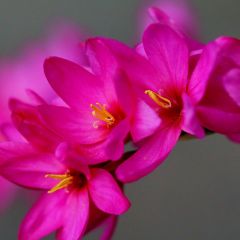
Ixia Venus - Corn lily
- Flowering time July to September
- Height at maturity 40 cm
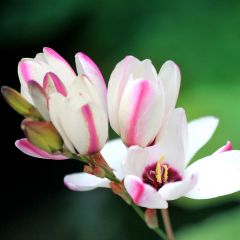
Ixia Spotlight - Corn lily
- Flowering time July to September
- Height at maturity 50 cm
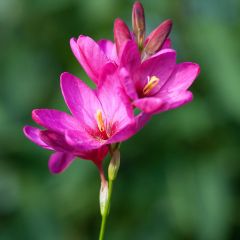
Ixia Rose Emperor - Corn lily
- Flowering time July to September
- Height at maturity 50 cm
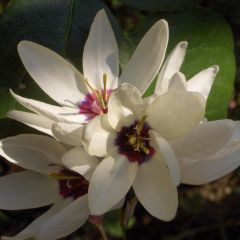
Ixia Giant - Corn lily
- Flowering time July to September
- Height at maturity 50 cm
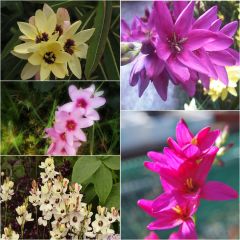
Ixia Mix - Corn lily
- Flowering time June to September
- Height at maturity 45 cm
Discover other Ixia
View all →Available in 1 sizes
Available in 1 sizes
Available in 1 sizes
Available in 1 sizes
Available in 1 sizes
Available in 1 sizes
Planting
Where to plant?
Plant ixias in full sun! Good light is necessary for the development of their flowers. Ixia prefers fairly warm, dry conditions and will do especially well in south of France.
Ixias prefer free-draining, permeable soils, as stagnant moisture could cause corms to rot. Before planting, add coarse sand or gravel to improve water infiltration in soil. They also like fertile soils, rich in humus. You can add organic matter, which will enrich soil as it breaks down.
Ixias can easily be grown in pots or containers, in a well-draining substrate. They will add lots of colour and vitality to a sunny terrace or courtyard. In addition, growing in pots makes it easy to bring them indoors for winter protection from cold, then put them out again in spring. It is also possible to grow ixias under glass in a greenhouse or conservatory, provided light is excellent.
When to plant?
We recommend planting corms in spring, around April… But if you live in an area with a mild climate, for example in south of France, prefer planting in autumn (around October). Likewise, if you grow ixias in pots, you can plant them in autumn and place pot under cover for winter.
How to plant?
For a better effect, we recommend planting ixias in groups rather than singly. Leave about 8 cm between corms.
For planting in open ground:
- Choose location and add coarse sand or gravel if necessary.
- Dig planting holes and place corms so they sit about ten centimetres deep. Ensure they are placed the right way up, point facing upwards. You can also put a thin layer of sand beneath each corm for drainage.
- Cover with soil and firm down.
- Water
You can also plant ixias in pots :
- Take a pot or container, place a drainage layer at bottom (gravel, clay pebbles, broken pottery…), then add a well-draining substrate (for example compost mixed with sand).
- Plant corms, point facing upwards.
- Cover with substrate and press down gently.
- Water.
- Place pot in full sun.

Care
You can water occasionally in spring and early summer, while the plant is growing and starting to flower. Water a little more when flower buds appear, and stop watering as soon as foliage wilts, because ixias need the soil to remain relatively dry during dormancy. With excess moisture, corms may rot. To encourage good flowering, you can also apply some fertiliser in spring and early summer.
If you live in a cold region, it is best to lift corms and bring them under cover for winter. Store them in a dry place. They will thus spend dormancy protected from frost. You can replant them in spring, around April. They are stored in the same way as gladioli. If you live in a mild climate and choose to leave corms in place over autumn, we nevertheless recommend applying a thick layer of mulch to protect them from cold.
During flowering, feel free to cut flowers for bouquets. With their long, slender flower stems, ixias are ideal for arrangements.
We suggest removing faded flowers regularly. As well as improving appearance, this encourages the plant to produce new ones!
Do not cut foliage immediately after flowering; leave it in place, as it allows the plant to rebuild its reserves for winter. Wait for it to wilt naturally before cutting it.
You can place a marker or label to remember their location and avoid damaging corms when working in the border.
Sometimes taller varieties require staking to maintain an upright, vertical habit.
Ixias are rarely affected by diseases or parasitic pests. Occasionally they may be struck by mosaic virus, which depigments foliage. There is no treatment; affected plants must be removed.
Propagation
Corm division
Simpler than sowing, corm division is carried out in early autumn, when ixias are lifted to be put under cover.
- Dig to lift ixia corms. Remove excess soil if necessary to make them clearly visible.
- Carefully separate them.
- Place them under cover, kept dry and protected from frost.
- Wait until spring, around April, to replant in open ground: work ground, add coarse sand if necessary, then plant 10 to 12 cm deep, cover and water.
Sowing
They can be propagated by sowing. Carry out in autumn, preferably using fresh seeds harvested recently.
- Prepare pot or seed tray, filling it with a free-draining substrate, for example a mix of potting compost and sand.
- Scatter seeds on surface.
- Cover them with about 5 mm of sieved substrate, and firm lightly.
- Water with a fine spray.
- Place pot in bright spot under cold frame.
Depending on species, expect two to three years before flowering.
Associating
Ixias are perfect for composing a very colourful mixed-border, with many bright flowers. Typically, they pair very well with other Iridaceae, plants of the same family: gladioli, acidantheras, Iris germanica, crocosmias… They share a very elegant, erect habit, fine foliage and an impressive flowering. Moreover, these flowers are ideal for cutting to create bouquets! Ixias complement gladioli very well because they require the same type of culture, the same conditions, are planted in the same way, and overwinter similarly. Their flowers blend wonderfully! You can pair ixias with the superb, very natural flowering of Gladiolus italicus. Also enjoy the splendid, light and airy flowering of Cosmos! Think also of the flowers of dahlias. For a touch of originality, you can add some Allium giganteum, with their large spherical inflorescences.
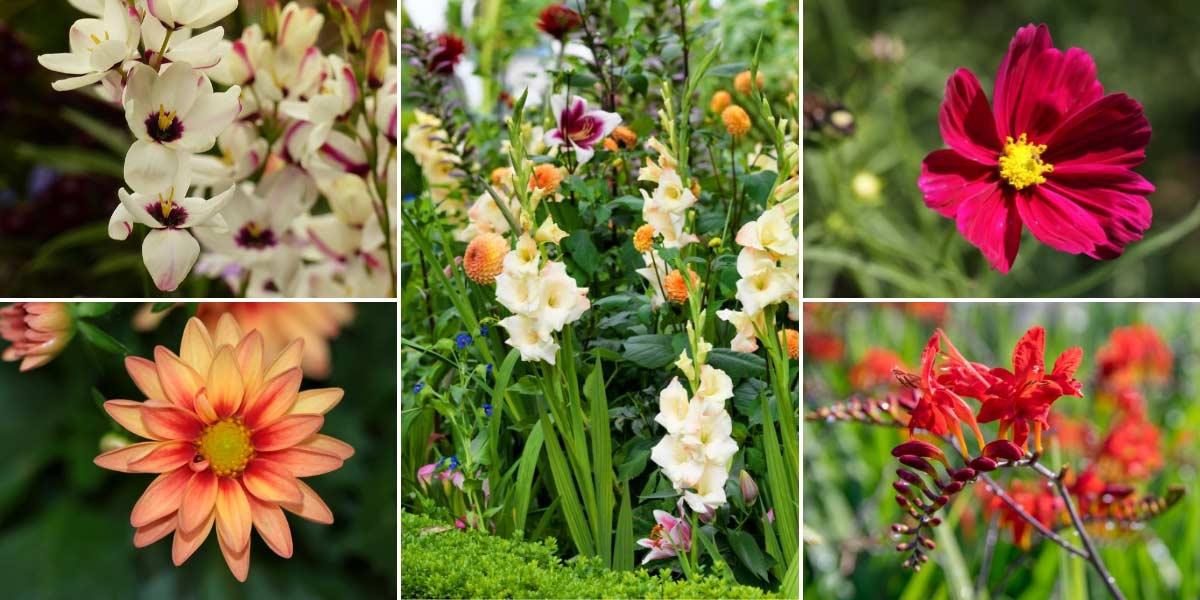
Ixias can be integrated into a border alongside colourful summer flowerings! Ixia ‘Spotlight’ / Dahlia x hortensis ‘Dahlietta’ (photo Harald Hoyer) / a scene with gladioli, dahlias and lilies (photo Steven Bemelman – iBulb) / Cosmos bipinnatus (photo Peak99) / Crocosmia
As ixias come in a wide range of shades, you can easily play with colours and create varied effects, harmonies or contrasts. Use ixias, for example, to create a blazing bed in warm tones, with yellow, orange and red flowers… Choose crocosmias, cannas, kniphofias, coreopsis, asclepias, rudbeckias… You can also add some dahlias. Add Pennisetum setaceum ‘Rubrum’, or Imperata cylindrica ‘Red Baron’. Also consider Eucomis for the exotic touch they bring. Discover too the impressive flowering of Eremurus, which bear long, very elegant, erect flower spikes.
However, to avoid a bed that is too overloaded with colours and visually “heavy”, do not hesitate to place small, airy flowers alongside ixias, such as those of gypsophilas and astrantias, or above all, decorative foliage, such as that of ornamental grasses, ferns, acanthus, cardoons (Cynara cardunculus)… Choose large-leaved plants for a lush effect and to showcase ixias’ flowering, creating a green setting that will make them stand out nicely rather than drowning them in a mass of colours and flowers!
Ixias with white, cream or soft-pink flowers can easily fit into a romantic bed. Opt, for example, for the variety ‘Spotlight’, which offers graceful white flowers with tepals shaded by a pink line. To accompany it, choose roses, gypsophilas, lilies, hardy geraniums, clematis, Campanula lactiflora…
If you grow them in pots, you can pair them with small, low or trailing flowers such as Bacopa or Lobelia. You can also choose pansies, verbenas, osteospermums, coreopsis… Create a composition that will bring plenty of colour to your terrace or courtyard!
→ Discover more ideas for pairing with Ixias in our advice sheet!
Useful resources
- Discover our range of Ixias
- An article by Ingrid on our blog – Planting bulbs? 7 practical and useful tips!
- Discover our article – Bulbs, corms, rootstocks… What are the differences?
Frequently asked questions
-
Can I leave my ixias in the ground over winter?
It's possible if you live in southern France. But elsewhere in the country, it's safer to overwinter them by bringing them indoors to protect them from frost. However, if you have a large number of young plants, you can overwinter most of them and test the rest by leaving them in the ground and protecting them with a thick layer of mulch.
-
Should I plant them in autumn or spring?
In regions with a mild climate, plant them in autumn; however, in the rest of France, it's better to wait until spring... they might not survive the winter in open ground.
- Subscribe!
- Contents
. Happy gardening! Ixia: Planting and Cultivation](https://en.promessedefleurs.eu/blogwp/wp-content/uploads/2019/04/ixia-tout-savoir.jpg)





































Comments